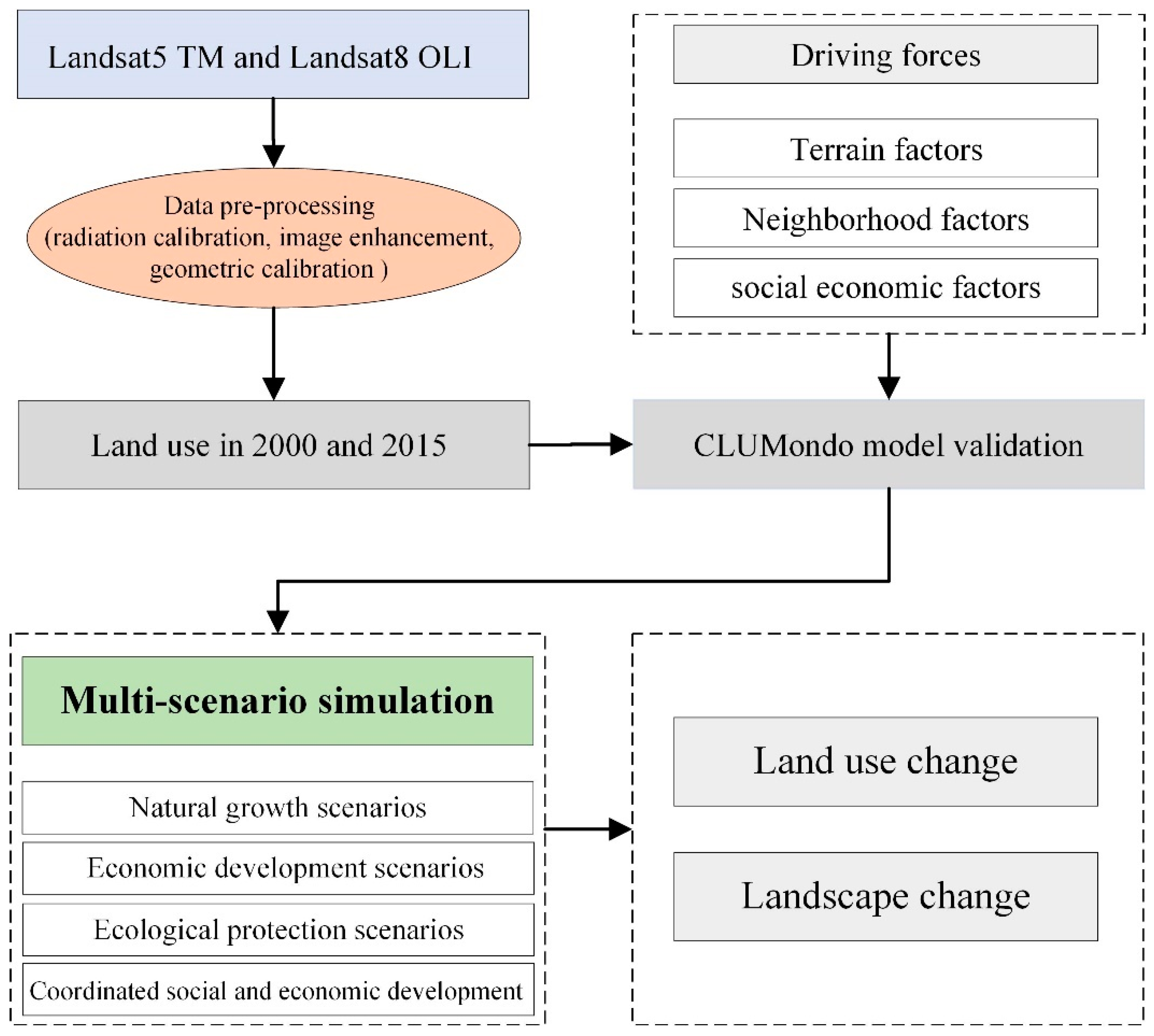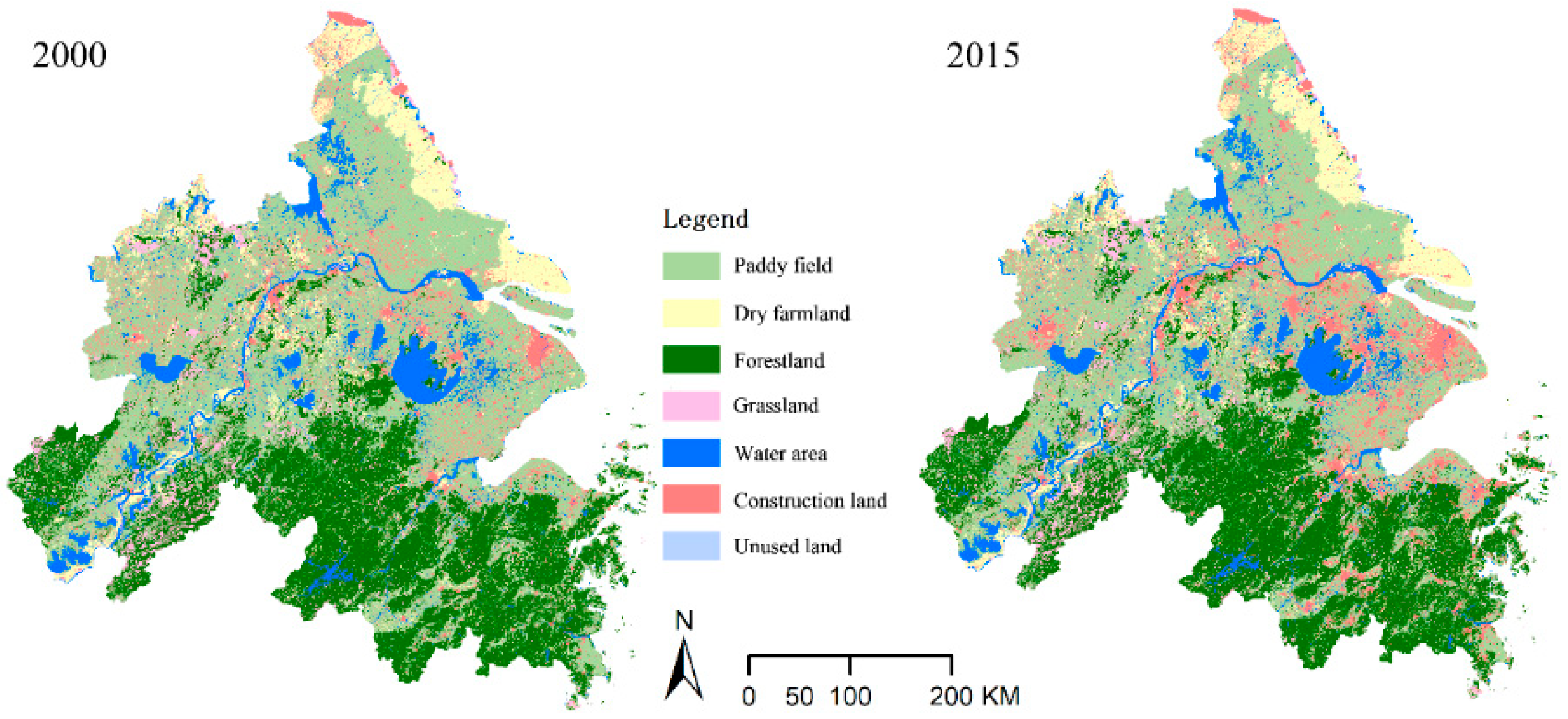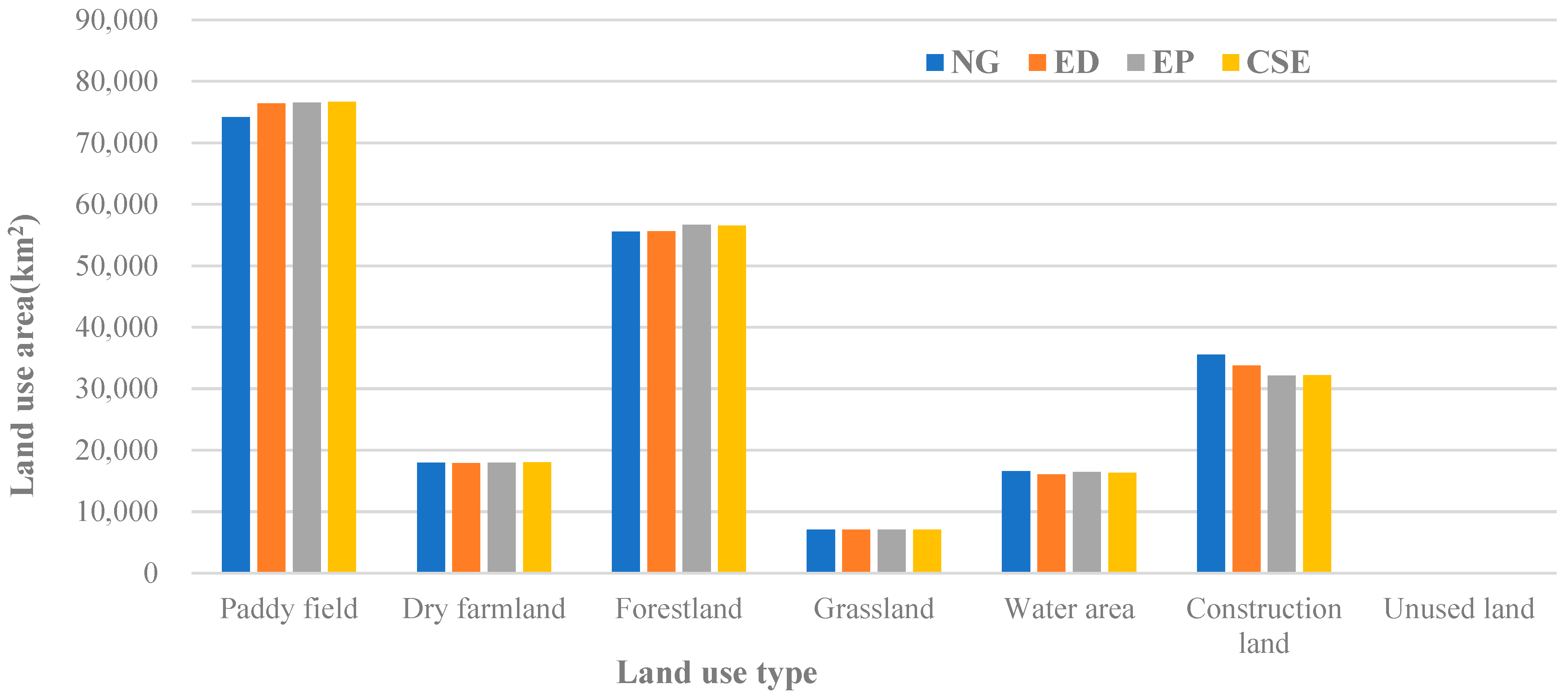A CLUMondo Model-Based Multi-Scenario Land-Use Change Simulation in the Yangtze River Delta Urban Agglomeration, China
Abstract
1. Introduction
2. Methods
2.1. Study Area
2.2. Data Collection and Processing
2.3. Study Methods
2.3.1. Markov Chain Model
2.3.2. CLUMondo Model
2.3.3. Simulation Scenarios
- (1)
- Natural growth (NG) scenarios
- (2)
- Economic development (ED) scenarios
- (3)
- Ecological protection (EP) scenarios
- (4)
- Coordinated social and economic development (CSE) scenarios
2.3.4. Model Validation
2.3.5. Landscape Pattern Analysis
3. Results
3.1. Changes in Land-Use Patterns
3.2. Land-Use Pattern Change Trend Simulations under Different Scenarios
3.3. Comparative Analysis of Ecosystem Pattern Changes under Different Scenarios
4. Discussion
5. Conclusions
Author Contributions
Funding
Institutional Review Board Statement
Informed Consent Statement
Data Availability Statement
Conflicts of Interest
References
- Mooney, H.A.; Duraiappah, A.; Larigauderie, A. Evolution of natural and social science interactions in global change research programs. Proc. Natl. Acad. Sci. USA 2013, 110, 3665–3672. [Google Scholar] [CrossRef]
- Shi, S.; Chang, Y.; Wang, G.; Li, Z.; Hu, Y.; Liu, M.; Li, Y.; Li, B.; Zong, M.; Huang, W. Planning for the wetland restoration potential based on the viability of the seed bank and the land -use change trajectory in the Sanjiang Plain of China. Sci. Total Environ. 2020, 733, 1–13. [Google Scholar] [CrossRef]
- Pereira, P.; Baro, F. Greening the city: Thriving for biodiversity and sustainability. Sci. Total Environ. 2022, 817, 153032. [Google Scholar] [CrossRef]
- Foley, J.A.; DeFries, R.; Asner, G.P.; Barford, C.; Bonan, G.; Carpenter, S.R.; Chapin, F.S.; Coe, M.T.; Daily, G.C.; Gibbs, H.K.; et al. Global consequences of land use. Science 2005, 309, 570–574. [Google Scholar] [CrossRef]
- Turner, B.L., II; Lambin, E.F.; Reenberg, A. The emergence of land change science for global environmental change and sustainability. Proc. Natl. Acad. Sci. USA 2007, 104, 20666–20671. [Google Scholar] [CrossRef]
- Seto, K.C.; Sanchez-Rodriguez, R.; Fragkias, M. The New Geography of Contemporary Urbanization and the Environment. Annu. Rev. Environ. Resour. 2010, 35, 167–194. [Google Scholar] [CrossRef]
- Kulmala, M.; Kokkonen, T.V.; Pekkanen, J.; Paatero, S.; Petaja, T.; Kerminen, V.-M.; Ding, A. Opinion: Gigacity–A source of problems or the new way to sustainable development. Atmos. Chem. Phys. 2021, 21, 8313–8322. [Google Scholar] [CrossRef]
- Wei, Y.; Wu, J.; Huang, J.; Liu, X.; Han, D.; An, L.; Yu, H.; Huang, J. Declining Oxygen Level as an Emerging Concern to Global Cities. Environ. Sci. Technol. 2021, 55, 7808–7817. [Google Scholar] [CrossRef]
- Yan, J.; Xu, Z.; Li, F.; Li, Y.; Chen, M.; Zhu, X.; Cui, X. Heavy metals in soil, water sediment, and ambient PM2.5 across the Yangtze River economic belt: Integrated environment risk identification and countermeasures. J. Water Clim. Change 2021, 12, 2920–2932. [Google Scholar] [CrossRef]
- Tian, G.; Ma, B.; Xu, X.; Liu, X.; Xu, L.; Liu, X.; Xiao, L.; Kong, L. Simulation of urban expansion and encroachment using cellular automata and multi-agent system model-A case study of Tianjin metropolitan region, China. Ecol. Indic. 2016, 70, 439–450. [Google Scholar] [CrossRef]
- Zhou, Z.C.; Wang, J. Evolution of landscape dynamics in the Yangtze River Delta from 2000 to 2020. Water Clim. Chang. 2022, 13, 1241–1256. [Google Scholar] [CrossRef]
- Li, B.; Hu, Y.; Chang, Y.; Liu, M.; Wang, W.; Bu, R.; Shi, S.; Qi, L. Analysis of the factors affecting the long-term distribution changes of wetlands in the Jing-Jin-Ji region, China. Ecol. Indic. 2021, 124, 107413. [Google Scholar] [CrossRef]
- Sturck, J.; Schulp, C.J.E.; Verburg, P.H. Spatio-temporal dynamics of regulating ecosystem services in Europe—The role of past and future land use change. Appl. Geogr. 2015, 63, 121–135. [Google Scholar] [CrossRef]
- Qiao, W.; Huang, X. Patterns of Urban Land Expansion and Its Driving Forces in Yangtze River Delta Urban Agglomeration. Econ. Geogr. 2021, 41, 162–173. [Google Scholar]
- Yan, Y.; Ju, H.; Zhang, S.; Jiang, W. Spatiotemporal Patterns and Driving Forces of Urban Expansion in Coastal Areas: A Study on Urban Agglomeration in the Pearl River Delta, China. Sustainability 2020, 12, 191. [Google Scholar] [CrossRef]
- Jia, Z.; Ma, B.; Zhang, J.; Zeng, W. Simulating Spatial-Temporal Changes of Land-Use Based on Ecological Redline Restrictions and Landscape Driving Factors: A Case Study in Beijing. Sustainability 2018, 10, 1299. [Google Scholar] [CrossRef]
- Liu, X.; Liang, X.; Li, X.; Xu, X.; Ou, J.; Chen, Y.; Li, S.; Wang, S.; Pei, F. A future land use simulation model (FLUS) for simulating multiple land use scenarios by coupling human and natural effects. Landsc. Urban Plan. 2017, 168, 94–116. [Google Scholar] [CrossRef]
- Liu, M.; Hu, Y.M.; Chang, Y.; He, X.Y.; Zhang, W. Land Use and Land Cover Change Analysis and Prediction in the Upper Reaches of the Minjiang River, China. Environ. Manag. 2009, 43, 899–907. [Google Scholar] [CrossRef]
- Verburg, P.H.; Soepboer, W.; Veldkamp, A.; Limpiada, R.; Espaldon, V.; Mastura, S.S.A. Modeling the spatial dynamics of regional land use: The CLUE-S model. Environ. Manag. 2002, 30, 391–405. [Google Scholar] [CrossRef]
- Fan, X.; Ma, Z.; Yang, Q.; Han, Y.; Mahmood, R. Land use/land cover changes and regional climate over the Loess Plateau during 2001–2009. Part II: Interrelationship from observations. Clim. Chang. 2015, 129, 441–455. [Google Scholar] [CrossRef]
- Xu, X.; Du, Z.; Zhang, H. Integrating the system dynamic and cellular automata models to predict land use and land cover change. Int. J. Appl. Earth Obs. Geoinf. 2016, 52, 568–579. [Google Scholar] [CrossRef]
- Van Asselen, S.; Verburg, P.H. Land cover change or land-use intensification: Simulating land system change with a global-scale land change model. Glob. Chang. Biol. 2013, 19, 3648–3667. [Google Scholar] [CrossRef]
- Liu, Z.F.; Verburg, P.H.; Wu, J.G.; He, C.Y. Understanding Land System Change Through Scenario-Based Simulations: A Case Study from the Drylands in Northern China. Environ. Manag. 2017, 59, 440–454. [Google Scholar] [CrossRef]
- Domingo, D.; Palka, G.; Hersperger, A.M. Effect of zoning plans on urban land-use change: A multi-scenario simulation for supporting sustainable urban growth. Sustain. Cities Soc. 2021, 69, 102833. [Google Scholar] [CrossRef]
- Wang, Y.; van Vliet, J.; Debonne, N.; Pu, L.; Verburg, P.H. Settlement changes after peak population: Land system projections for China until 2050. Landsc. Urban Plan. 2021, 209, 104045. [Google Scholar] [CrossRef]
- Wang, X.; Che, L.; Zhou, L.; Xu, J. Spatio-temporal Dynamic Simulation of Land use and Ecological Risk in the Yangtze River Delta Urban Agglomeration, China. Chin. Geogr. Sci. 2021, 31, 829–847. [Google Scholar] [CrossRef]
- Chen, Z.; Huang, M.; Zhu, D.; Altan, O. Integrating Remote Sensing and a Markov-FLUS Model to Simulate Future Land Use Changes in Hokkaido, Japan. Remote Sens. 2021, 13, 2621. [Google Scholar] [CrossRef]
- Tian, G.; Jiang, J.; Yang, Z.; Zhang, Y. The urban growth, size distribution and spatio-temporal dynamic pattern of the Yangtze River Delta megalopolitan region, China. Ecol. Model. 2011, 222, 865–878. [Google Scholar] [CrossRef]
- Yu, M.; Yang, Y.; Chen, F.; Zhu, F.; Qu, J.; Zhang, S. Response of agricultural multifunctionality to farmland loss under rapidly urbanizing processes in Yangtze River Delta, China. Sci. Total Environ. 2019, 666, 1–11. [Google Scholar] [CrossRef]
- Cao, M.; Tang Ga Shen, Q.; Wang, Y. A new discovery of transition rules for cellular automata by using cuckoo search algorithm. Int. J. Geogr. Inf. Sci. 2015, 29, 806–824. [Google Scholar] [CrossRef]
- Bai, X.; Shi, P.; Liu, Y. Realizing China’s urban dream. Nature 2014, 509, 158–160. [Google Scholar] [CrossRef] [PubMed]
- Turner, M.G. Spatial and Temporal Analysis of Landscape Patterns. Landsc. Ecol. 1990, 4, 21–30. [Google Scholar] [CrossRef]
- Li, Z.; Liu, M.; Hu, Y.; Xue, Z.; Sui, J. The spatiotemporal changes of marshland and the driving forces in the Sanjiang Plain, Northeast China from 1980 to 2016. Ecol. Process. 2020, 9. [Google Scholar] [CrossRef]
- Li, X.Z.; He, H.S.; Bu, R.C.; Wen, Q.C.; Chang, Y.; Hu, Y.M.; Li, Y.H. The adequacy of different landscape metrics for various landscape patterns. Pattern Recognit. 2005, 38, 2626–2638. [Google Scholar] [CrossRef]
- He, Q.; Zeng, C.; Xie, P.; Tan, S.; Wu, J. Comparison of urban growth patterns and changes between three urban agglomerations in China and three metropolises in the USA from 1995 to 2015. Sustain. Cities Soc. 2019, 50, 101649. [Google Scholar] [CrossRef]
- Yu, Z.; Chen, L.; Li, L.; Zhang, T.; Yuan, L.; Liu, R.; Wang, Z.; Zang, J.; Shi, S. Spatiotemporal Characterization of the Urban Expansion Patterns in the Yangtze River Delta Region. Remote Sens. 2021, 13, 4484. [Google Scholar] [CrossRef]
- Shen, Z.; Xu, X.; Xu, S.; Sun, D. A comparative study of land development patterns and regional thermal environments (RTEs) in typical urban agglomerations of China and America: A case study of Beijing-Tianjin-Hebei (BTH) and Boswash. Sci. Total Environ. 2022, 803, 149735. [Google Scholar] [CrossRef]
- Sun, N.; Zhu, W.; Cheng, Q. GF-1 and Landsat observed a 40-year wetland spatiotemporal variation and its coupled environmental factors in Yangtze River estuary. Estuar. Coast. Shelf Sci. 2018, 207, 30–39. [Google Scholar] [CrossRef]
- Wu, M.; Li, C.; Du, J.; He, P.; Zhong, S.; Wu, P.; Lu, H.; Fang, S. Quantifying the dynamics and driving forces of the coastal wetland landscape of the Yangtze River Estuary since the 1960s. Reg. Stud. Mar. Sci. 2019, 32, 100854. [Google Scholar] [CrossRef]
- Feng, Y.; Liu, Y.; Tong, X. Comparison of metaheuristic cellular automata models: A case study of dynamic land use simulation in the Yangtze River Delta. Comput. Environ. Urban Syst. 2018, 70, 138–150. [Google Scholar] [CrossRef]
- Lin, G.; Jiang, D.; Fu, J.; Cao, C.; Zhang, D. Spatial Conflict of Production-Living-Ecological Space and Sustainable-Development Scenario Simulation in Yangtze River Delta Agglomerations. Sustainability 2020, 12, 2175. [Google Scholar] [CrossRef]
- Zhang, S.; Shao, H.; Li, X.; Xian, W.; Shao, Q.; Yin, Z.; Lai, F.; Qi, J. Spatiotemporal Dynamics of Ecological Security Pattern of Urban Agglomerations in Yangtze River Delta Based on LUCC Simulation. Remote Sens. 2022, 14, 296. [Google Scholar] [CrossRef]
- Qiao, W.; Guan, W.; Huang, X. Assessing the Potential Impact of Land Use on Carbon Storage Driven by Economic Growth: A Case Study in Yangtze River Delta Urban Agglomeration. Int. J. Environ. Res. Public Health 2021, 18, 11924. [Google Scholar] [CrossRef] [PubMed]






| Explanatory | Data Source |
|---|---|
| Euclidean distance to the: Urban area | Map of land use |
| Village | Map of land use |
| Main road | Map of road networks |
| Railway | Map of road networks |
| Express railway | Map of road networks |
| River | Map of land use |
| Airport | Baidu Map |
| Port | Baidu Map |
| DEM | RESDC |
| Slope | RESDC |
| Gross domestic product | RESDC |
| Population density | RESDC |
| Indices/Units | Description |
|---|---|
| NP (None) | Number of patches. |
| LSI (None) | The deviation between the patch and same area of the circle. |
| SIDI (None) | Reflects the heterogeneity of the landscape. |
| SHEI (None) | Reflects the maximum possible diversity of the landscape under a certain landscape abundance. |
| CONTAG (%) | Reflects the connectivity; the larger the value, the stronger the integrity. |
| AI (%) | Reflects the degree of aggregation; a large AI value implies a landscape composed of large patches or a high degree of connection between patches. |
| 2000 | 2015 | |||
|---|---|---|---|---|
| Area (km2) | Proportion (%) | Area (km2) | Proportion (%) | |
| Paddy field | 90,616.5 | 43.81 | 83,300.7 | 40.27 |
| Dry farmland | 19,829.6 | 9.59 | 19,079.5 | 9.22 |
| Forestland | 57,382.8 | 27.74 | 56,849.7 | 27.49 |
| Grassland | 7239.8 | 3.50 | 7241.4 | 3.50 |
| Water area | 15,584.8 | 7.53 | 16,026.5 | 7.75 |
| Construction land | 16,149.0 | 7.81 | 24,288.5 | 11.74 |
| Unused land | 33.1 | 0.02 | 49.3 | 0.02 |
| 2015 | Paddy Field | Dry Farmland | Forestland | Grassland | Water Area | Construction Land | Unused Land | |
|---|---|---|---|---|---|---|---|---|
| 2000 | ||||||||
| Paddy field | 82,171.53 | 84.96 | 368.04 | 28.57 | 194.17 | 335.71 | 0.12 | |
| Dry farmland | 104.76 | 18,650.50 | 104.93 | 45.18 | 66.43 | 80.44 | 0.06 | |
| Forestland | 375.22 | 84.76 | 56,148.45 | 115.54 | 22.93 | 19.91 | 1.11 | |
| Grassland | 47.62 | 10.02 | 153.42 | 6938.61 | 73.47 | 7.42 | 0.07 | |
| Water area | 818.99 | 60.55 | 43.48 | 40.50 | 15,004.80 | 33.98 | 0.67 | |
| Construction land | 6978.73 | 911.78 | 453.37 | 55.80 | 199.78 | 15,652.09 | 2.09 | |
| Unused land | 10.63 | 1.13 | 4.89 | 1.99 | 1.07 | 0.57 | 28.88 | |
| NP | LSI | SIDI | SHEI | CONTAG | AI | |
|---|---|---|---|---|---|---|
| 2015 | 53,392 | 135.73 | 0.730 | 0.773 | 37.19 | 70.50 |
| NG | 54,450 | 130.48 | 0.755 | 0.799 | 36.12 | 71.67 |
| ED | 53,557 | 129.28 | 0.750 | 0.794 | 36.57 | 71.94 |
| EP | 53,478 | 128.80 | 0.749 | 0.793 | 36.64 | 72.04 |
| CSE | 53,893 | 129.37 | 0.748 | 0.792 | 36.61 | 71.92 |
Publisher’s Note: MDPI stays neutral with regard to jurisdictional claims in published maps and institutional affiliations. |
© 2022 by the authors. Licensee MDPI, Basel, Switzerland. This article is an open access article distributed under the terms and conditions of the Creative Commons Attribution (CC BY) license (https://creativecommons.org/licenses/by/4.0/).
Share and Cite
Zhao, Y.; Su, D.; Bao, Y.; Yang, W.; Sun, Y. A CLUMondo Model-Based Multi-Scenario Land-Use Change Simulation in the Yangtze River Delta Urban Agglomeration, China. Sustainability 2022, 14, 15336. https://doi.org/10.3390/su142215336
Zhao Y, Su D, Bao Y, Yang W, Sun Y. A CLUMondo Model-Based Multi-Scenario Land-Use Change Simulation in the Yangtze River Delta Urban Agglomeration, China. Sustainability. 2022; 14(22):15336. https://doi.org/10.3390/su142215336
Chicago/Turabian StyleZhao, Yanhua, De Su, Yang Bao, Wei Yang, and Yibo Sun. 2022. "A CLUMondo Model-Based Multi-Scenario Land-Use Change Simulation in the Yangtze River Delta Urban Agglomeration, China" Sustainability 14, no. 22: 15336. https://doi.org/10.3390/su142215336
APA StyleZhao, Y., Su, D., Bao, Y., Yang, W., & Sun, Y. (2022). A CLUMondo Model-Based Multi-Scenario Land-Use Change Simulation in the Yangtze River Delta Urban Agglomeration, China. Sustainability, 14(22), 15336. https://doi.org/10.3390/su142215336





